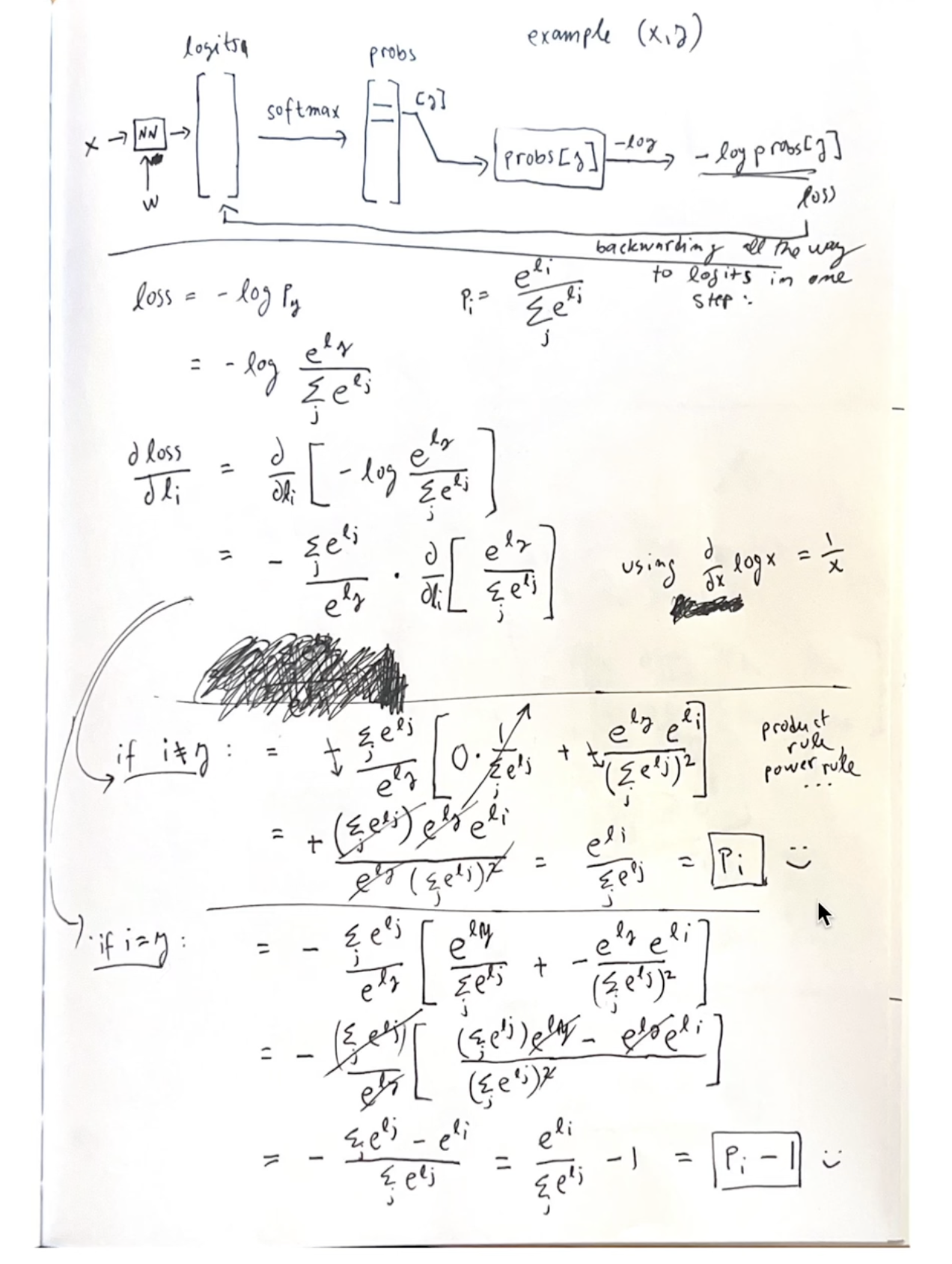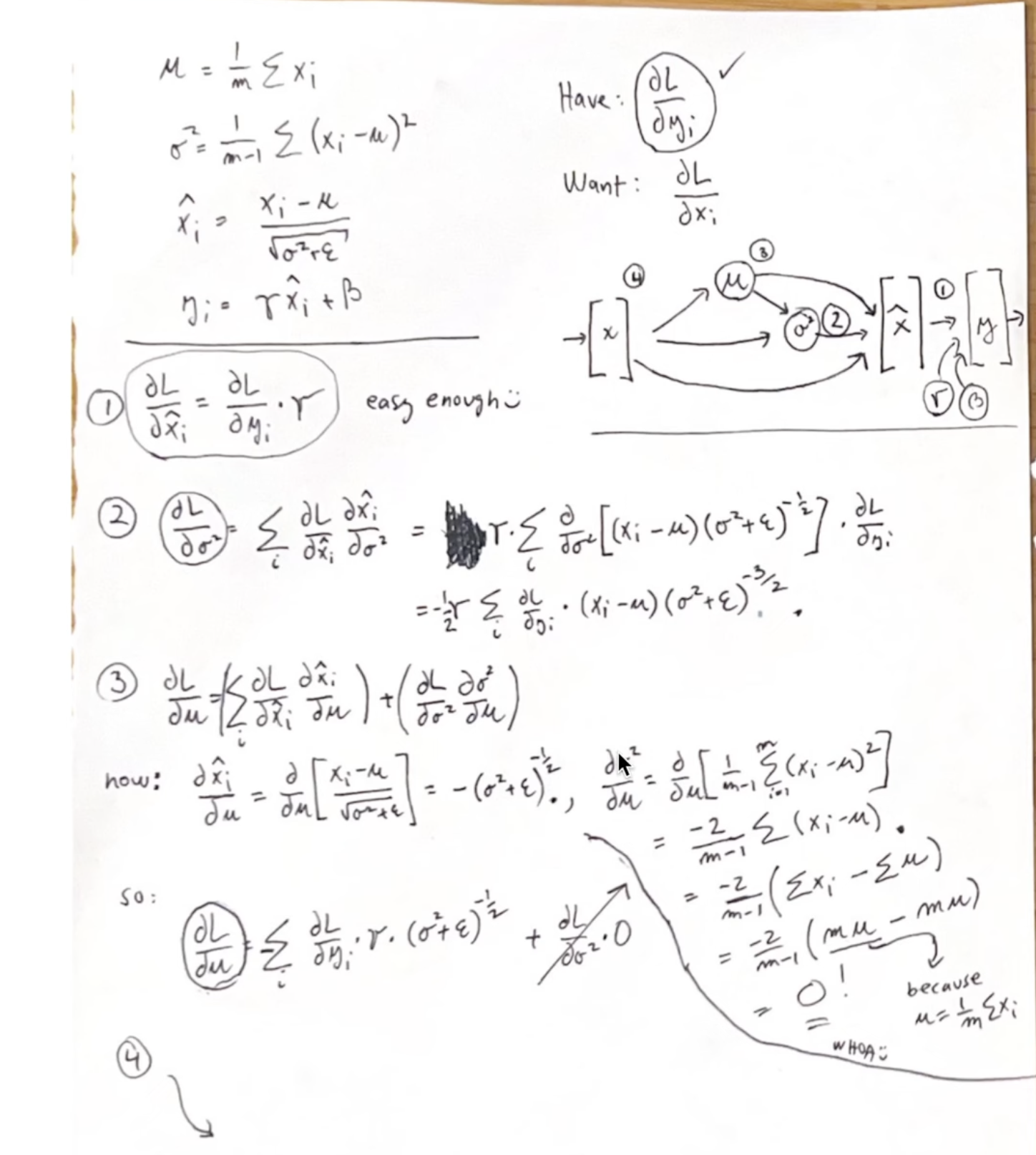Andrej Karpathy-Backprop
Andrej explain his own blog in this lecture.

1 Gradients
- Basic operatinos w Chain Rule
# batch_size 32, embed_size 27 #logprobs.shape = [32, 27] #loss = -logprobs[range(n), Yb].mean() dlogprobs = torch.zeros_like(logprobs) dlogprobs[range(n), Yb] = -1.0/n #logprobs = probs.log() dprobs = (1.0 / probs) * dlogprobs - Sum over all grad contributions
# counts.shape = [32, 27] # counts_sum_inv.shape == [32, 1] # dprobs.shape = [32, 27] #probs = counts * counts_sum_inv dcounts_sum_inv = (counts * dprobs).sum(1, keepdim=True) # The SUM!!! dcounts = counts_sum_inv * dprobs - Use power -1 instead of reciprocal
# counts_sum.shape == [32, 1] #counts_sum_inv = counts_sum**-1 dcounts_sum = (-counts_sum**-2) * dcounts_sum_inv - Addition is simply a route for grads.
#counts_sum = counts.sum(1, keepdims=True) # use += to add this update to dcounts dcounts += torch.ones_like(counts) * dcounts_sum .exp()is the simplest#counts = norm_logits.exp() dnorm_logits = (norm_logits.exp()) * dcounts = counts * dcounts- Subtraction is also a route for grads but with a negative sign
Since the subtraction here is only for numerical stability reason, so thedlogit_maxesshould be zero and actually it is (very small values)# subtract max for numerical stability # logits.shape == [32, 27] # logit_maxes.shape == [32, 1] #norm_logits = logits - logit_maxes dlogits = dnorm_logits.clone() #clone for satety dlogit_maxes = (-1*dnorm_logits).sum(1, keepdim=True) - Max operra
maxreturns bothvalueandindices- use
F.one_shotto generate one shot vectors for the correct max positions
# F.one_shot().shape == [32, 27] #logit_maxes = logits.max(1, keepdim=True).values dlogits += F.one_hot(logits.max(1).indices, num_classes=logits.shape[1]) * dlogit_maxes
- Matrix multiplication

 The trick here is the see how matrix dim can match.
The trick here is the see how matrix dim can match.
# logits.shape == [32, 27] # h.shape == [32, 64] W2.shape == [64, 27] # b2.shape == [27] # logits = h @ W2 + b2 # [32,27] + [27] --> [32,27] + [32,27] dh = dlogits @ W2.T dW2 = h.T @ dlogits db2 = dlogits.sum(0, keepdim=False) - Tanh
# Non-linearity h = torch.tanh(hpreact) # hidden layer dhpreact = (1-h**2) * dh - Bessel’correction for variance
unbiased variance estimation by dividing n-1
Batches are just a small sample, so it’s suggets to use the unbiased estimation.
# unbiased variance estimation #bnvar = 1/(n-1)*(bndiff2).sum(0, keepdim=True) # bnvar.shape == [1,64] # bndiff2.shape == [32,64] dbndiff2 = (1/(n-1))*torch.ones_like(bndiff2)*dbnvarThis is different from grads for
sum(1)as we don’t sum over but simply do assignment - concatenataion
Simply revert to the original shape
# embcat.shape == [32, 30] # emb.shape == [32, 3, 10] # embcat = emb.view(emb.shape[0], -1) demb = dembcat.view(emb.shape) - Indexing
Also a re-route similar to concat, but need to find the correct indexing
# emb.shape == [32, 3, 10] # C.shape == [27, 10] # Xb.shape == [32, 3] # emb = C[Xb] dC = torch.zeros_like(C) for k in range(Xb.shape[0]): for j in range(Xb.shape[1]): ix = Xb[k,j] dC[ix] += demb[k,j]
2 Simple solution for cross_entropy

#loss = F.cross_entropy(logits, Yb)
dlogits = F.softmax(logits, 1)
dlogits[range(n), Yb] -= 1
dlogits /= n
3 Simple solution for Batch Norm
Pretty tricky math here


#hpreact = bngain * (hprebn - hprebn.mean(0, keepdim=True)) / torch.sqrt(hprebn.var(0, keepdim=True, unbiased=True) + 1e-5) + bnbias
dhprebn = bngain*bnvar_inv/n * (n*dhpreact - dhpreact.sum(0) - n/(n-1)*bnraw*(dhpreact*bnraw).sum(0))